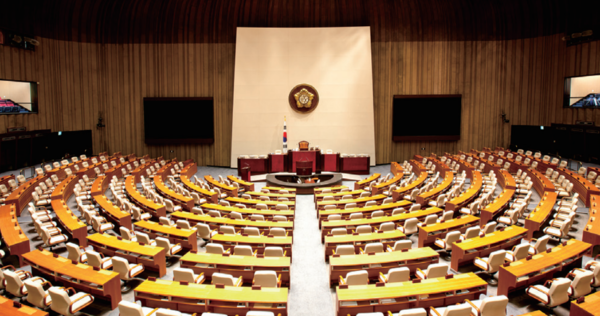This February, the National Pension Service announced that the number of pension subscribers will decrease by more than 100,000 in the following two years, due to a low birth rate and aging population. Despite the ongoing decline, the discussion on pension reform was continuously hindered by the political strife between the ruling People Power Party and the main opposition, Democratic Party of Korea. In light of this, the Sungkyun Times (SKT) will examine the current state of the reform and explore potential solutions.
Unveiling Pension Reform
-The Blueprint for Tomorrow

The national pension system, which was first introduced in 1988, is a social security service that aims to ensure income stability after retirement. When workers aged 18 to 59 enroll in the plan and pay insurance premiums for over 10 years, they become eligible to receive a pension. The government also provides disability pensions to people with disabilities caused by illnesses or injuries and a survivor’s pension to the bereaved family if the pension subscriber dies. As for the components of the pension system, the insurance premium, an amount subscribers pay monthly, is fixed at 9% of the subscriber’s reported income. Meanwhile, the subscriber’s pension benefits are determined by the income replacement rate, which is the amount of pension receivable compared to the average income earned during the subscription period, adjusted to its current value. Currently, the replacement rate is set at 41.5% for a person enrolled for more than 40 years. The national pension system subjects all income earners to obligatory subscription to prevent people from opting out of participation or evading payment. It also plays a redistribution role in closing the gap across income levels and generations — low-income groups receive a relatively higher return proportion of pension while young workers contribute to the assistance of the elderly. Indeed, the national pension plan guarantees a fixed pension and the recovery of the principal amount regardless of fund performance, making it an essential scheme for people with difficulties making individual retirement preparations.
-Where Progress Meets Delay
As the number of young workers diminishes in contrast to the growing number of recipients, concerns are rising over the sustainability of pension funds. According to Statistics Korea, the total fertility rate declined from 1.48 in 2000 to 0.75 in 2024, the lowest rate in the world. Moreover, the National Assembly Budget Office’s 2023 projection stated that the pension fund would begin facing a deficit in 2041 and become depleted by 2055. As the system undergoes challenges, the need for pension reform became more apparent. The reform would most likely be in the form of adjusting the insurance premium rate or the income replacement ratio. However, it has been difficult to reach an agreement as the interests of different stakeholders have continuously collided. The first reform took place in 1998, where the income replacement rate was lowered from 70% to 60%, and the pension eligibility age was raised from 60 to 65. In 2007, the second and last reform instance further revised the income replacement rate, having it gradually decrease to 40% by 2028. While the government has been actively pursuing a reform, significant struggles still remain.
A Divided House
-The Parametric Reform
There are two main approaches to pension reform: parametric and structural reform. Parametric reform involves adjusting variables such as the insurance premium or income replacement rate while maintaining the overall framework. The conflicting aspect mainly lied in the income replacement rate, as it only benefits current beneficiaries when increased, unlike the insurance premium rate, which would place an increasing burden on active contributors. Initially, both ruling and opposition parties agreed to increase the insurance premium rate to 13%, but remained discordant over the range and timing of the income replacement rate for a prolonged period. The ruling party prioritized stabilizing the fund by only slightly increasing the income replacement rate to between 43% and 44%. However, it insisted that this could be addressed later as the payouts would only begin to exceed pension revenue in 2027, asserting that adjusting the premium rate is the most essential part at the moment. In contrast, the opposition party advocated a higher insurance premium rate to assure future security. It also argued that both the insurance premiums and income replacement rates should be adjusted simultaneously to ensure retirees’ financial stability. While adjusting the income replacement rate could help stabilize the pension fund, premature changes in regulations could increase labor costs and reduce employment, making it essential to decide on the right timing. Following years of discussions, both parties finally reached a consensus on fixing the replacement rate at 43% in March 14th. However, challenges still lie ahead.

-The Structural Reform
A structural reform would restructure the pension system and revise its functions. Compared to parametric reform, it is expected to secure financial sustainability, ensuring that tax revenues and government assets will continue to cover public expenditures effectively. However, drawing a social consensus is a tough challenge as it presents a wide range of discussion points. Among the debated issues that delayed the agreement was which institution should be responsible for the reform. Both parties agreed on the necessity of structural reform. However, the ruling party held that the reform should be discussed within a special pension reform committee, while the opposing party hoped to first examine it within the standing Health and Welfare Committee, and then, a special committee. Progress was delayed due to such continued political divisions until a motion was finally passed last March 20th to launch a special parliamentary committee composed of 13 members from the ruling party, main opposition party, and a non-negotiating group. Another point at issue is whether to introduce an automatic adjustment system, which would automatically adjust insurance premiums and income replacement rates based on demographic and economic changes. Currently, the national pension only makes adjustments based on inflation fluctuations. However, if the automatic adjustment mechanism is implemented, the number of subscribers and changes in life expectancy would also be reflected. The ruling party advocates this method since necessary pension adjustments would be made without long, formal discussions. However, the opposition party disapproves, claiming that it would decrease pension benefit payments compared to the current system. Despite the critical need for financial stability, disagreements between the parties are delaying the progress of further reforms.
-The Lost Trust
Unresolved discussions over pension reform increase public uncertainty about the future, further eroding trust in the pension system. According to a survey conducted last year by Youth Action for Pension Reform, 3 out of 10 young respondents answered that the national pension system should be abolished. This shows that the younger generation harbors deep distrust toward the national pension and fears that the reform will ultimately disadvantage them. Despite widespread distrust, there has been minimal progress over the years. For instance, President Yoon Suk-yeol vowed to complete the task during his candidacy, establishing a presidential office agency. Nonetheless, after his election, the responsibility was transferred to the National Assembly, which established a special committee on pension reform. Moreover, when the committee submitted a reform plan based on a public opinion survey conducted with 500 citizens, the presidential office deferred the issue to the 22nd Assembly, rejecting the proposal. Subsequently, the government announced a national pension reform plan on September 2024, but discussions were disrupted because of the martial law imposed last December, being reignited only recently. Lastly, because there are no specific legislations guaranteeing that public funds must cover pension shortfalls, public anxiety has been amplified. Although the National Pension Act of Korea stipulates that the government should establish measures to ensure that pension benefits are provided stably, it does not explicitly guarantee the payment. In an interview with the SKT, a worker in her thirties said, “As I am about to get married, I am happy but also worried about the future, and seeing no progress on pension reform only adds to my concerns.”

The Road to a Sustainable Future
-The Path of Reform
The objectives of pension reform not only lie in delaying fund depletion but also in achieving permanent financial stability. As such, whether through parametric or structural reforms, the government must take the lead in initiating changes. In the case of Canada, the pension fund was secured through solely parametric reforms. The government stabilized the Canada Pension Plan and ensured the adequacy of benefits for the middle class by raising the insurance premiums and income rates in two rounds of reforms. Here, the insurance premium rate was gradually increased to 33% by 2025, while the income rate remained at 25%. On the other hand, Japan is an example of a country that successfully implemented both structural and parametric reforms. During the early transitional stages from 1942 to 1989, Japan implemented structural reforms to change the functions and roles of the system for stable operation. Then, from 1994 to 2020, during the stabilization period, Japan conducted parametric reforms to secure financial stability, preparing for its aging society. Its structural reform in 1985 changed the system from one that increased pension benefits with the length of the subscription period to one that determined payouts based on the individual’s date of birth. If Korea prioritizes the sustainability of pension funds and applies lessons from various examples, it will achieve long-term financial stability for pension beneficiaries.

-Earning Trust, Building Futures
To succeed in pension reform, it is essential that the public fully understands its purpose. The government can gain the public’s trust by being receptive to their concerns and implementing continued changes. For instance, in 2014, the United Kingdom completed two significant reforms using this method. Its Pensions Commission published accurate informations about the pension system and maintained tranparency, helping its citizens understand the situation and the necessity of a reform. Korea has a mechanism called the National Petition System that may be useful. This online platform allows citizens to make their concerns heard and receive official responses directly from the government. Therefore, making use of such systematic infratructures would help increase public acceptance by enabling people to understand and speak up about proposed changes. Additionally, the details of the pension system should be legislated to build trust among the young generation. For example, since 1999, Sweden has legally fixed the pension insurance premium rate at 18.5%. This has contributed to social stability by providing predictability and reliability to the pension system. In an interview with the SKT, Professor Kim Jae-seung of the Department of Social Welfare stated, “Stabilizing pension finances is essential, sharing the burden across generations to ensure sustainability.” If Korea implements reforms through public participation and clear legal guarantees, it can achieve both national financial stability and higher trust levels.
Pension reform — it is the elephant in the room. Despite its unsettling nature, it is a conversation that must be had, making reform inevitable. Both political parties must continue to put aside their conflicting interests and work together for the benefit of the nation. Kingos, please remember: the longer the public ignores the elephant, the bigger it becomes.
